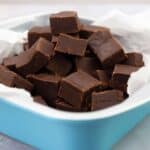Old Fashioned Chocolate Fudge Recipe
Simple ingredients come together to make the perfect fudge!
Servings: 36 2" pieces
Calories: 89kcal
Equipment
- Ninja Foodi Possible Cooker Pro OR
- Ninja Foodi Pressure Cooker & Air Crisper or
- 6 quart pot for stovetop cooking
Ingredients
- 3 cups granulated sugar
- ⅓ cup dark cocoa powder unsweetened
- ⅓ cup regular cocoa powder unsweetened
- 1 Tablespoon espresso powder for baking
- ¼ teaspoon kosher or fine grind sea salt
- 1½ cups whole milk divided in recipe
- 5 Tablespoons salted or unsalted butter room temp. Have a little extra butter available to butter the pan.
- 1 Tablespoon vanilla paste or vanilla extract
Instructions
Prep for Recipe
- Butter the corners and sides of an 8"x8" baking pan (sides of the pan should be at least 2" high). Cut two pieces of parchment about 8"x12" and place one piece into the pan and press it down so it adheres to the pan. Place the other piece in the opposite direction and press it into the pan. Butter a silicone spatula and set it to the side.
Ninja Possible Cooker Instructions (see recipe notes for other cooking methods)
- Turn the Ninja Foodi Possible Pro Cooker on HIGH sear/sauté. Add the sugar, espresso powder, salt and cocoa powders.3 cups granulated sugar, ⅓ cup dark cocoa powder, ⅓ cup regular cocoa powder, 1 Tablespoon espresso powder for baking, ¼ teaspoon kosher or fine grind sea salt
- Add ¾ cup of the whole milk and whisk to incorporate the sugar and cocoa with the milk and form a thick paste-like mixture. This makes it easier to remove all the clumps rather than adding in all the milk at once. Gradually add the remaining milk into the sugar/cocoa mixture and stir frequently.1½ cups whole milk
- Continue to stir the mixture until the Ninja Foodi Possible Pro Cooker has finished preheating and when it says to "add food" don't do anything. It will start counting up in time on its own. *DO NOT PUT THE LID ON
- Once you see the timer on the display, reduce the sear/sauté temperature to low and do not stir. Allow the mixture to come to a boil and cook for 25 minutes or until the temperature reaches 234-238℉/112-114℃. This is the soft ball stage and what you want for fudge. See recipe notes for the cold water test if you don't have a thermometer and just want to double check that you have reached soft ball stage.
- Add the butter and vanilla paste, but do not stir!5 Tablespoons salted or unsalted butter, 1 Tablespoon vanilla paste or vanilla extract
- Immediately remove the pot from the Possible Cooker and place the pot on a heat resistant surface like a wood cutting board. Let the fudge cool for 15 minutes undisturbed. The temperature should be less than 150℉/65℃
- Using a wooden spoon, start stirring the fudge mixture vigorously for about 6 minutes. You will begin to see the fudge thicken and as soon as you can part the mixture with your spoon and it doesn't flow quickly back together, pour the fudge into the lined pan and use the buttered spatula to scrape the fudge from the bottom of the pot.
- If your fudge began to harden too quickly and didn't flow into the pan well, you can place a piece of parchment over the top and gently press it into the pan so that the fudge is in an even layer.
- Let the fudge sit, uncovered, at room temperature for 2 hours before cutting it. Cut into 2" squares and serve at room temperature.
Notes
Ninja Foodi Pressure Cooker Instructions
The process and ingredients are exactly same when making this recipe in the Ninja Foodi. The ONLY changes are:
- You won't have the preheat time, but the mixture still only needs to cook for 25 minutes.
- Instead of switching to low sear/sauté once the mixture is boiling, reduce the heat to medium.
- Bring the sugar, cocoa powders, salt, espresso, and milk to a boil and reduce the heat to medium. The mixture should still be boiling and continue to boil until the temperature reaches 238℉/114℃ which is soft ball stage.
- Once soft ball stage is reached, add the butter and vanilla. Do NOT stir.
- Allow the pot to cool until the temperature reaches 150℉/65℃
- Follow the rest the instructions as written.
- Fill a bowl with very cold water
- Drop just a small amount (like ⅛ of a teaspoon) of the fudge mixture into the cold water and it should immediately form a soft ball that is formed.
- When removed from the water it should flatten just a bit and feel soft.
- If the ball does not form in the water, the fudge has not reached soft ball stage. If the ball doesn't feel soft, it has gone past soft ball stage.
Nutrition
Serving: 1piece | Calories: 89kcal | Carbohydrates: 18g | Protein: 1g | Fat: 2g | Saturated Fat: 1g | Polyunsaturated Fat: 0.1g | Monounsaturated Fat: 1g | Trans Fat: 0.1g | Cholesterol: 5mg | Sodium: 33mg | Potassium: 45mg | Fiber: 1g | Sugar: 17g | Vitamin A: 65IU | Calcium: 15mg | Iron: 0.2mg
